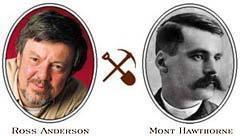
CHILKOOT SUMMIT - Perched on a rocky promontory that straddles the U.S.-Canada boundary, two women in khaki and green shirts are engaged in high-level diplomacy - 3,500 feet high, to be exact.
Still recovering from my climb, your reporter intervenes.
Donna Hoitsma, a U.S. park ranger based at Sheep Camp, patrols 16 miles of the Chilkoot Trail between here and Dyea.
Libby Gunn, a Parks Canada warden, is based here at the summit and patrols the 16 miles east to Bennett.
Both are young and unspeakably fit. While your reporter has panted and struggled up the storied Chilkoot ascent, Hoitsma has virtually pranced up, whistling all the way. Her performance leaves me feeling grimly 50-ish.
Now they nibble at a light lunch while comparing notes on bear problems at Lindeman and the previous day's rescue of an injured hiker.
"We meet as frequently as we can," Hoitsma says. "It beats the heck out of trying to sort things out over the radio."
The Klondike Park, which extends, in a sense, from Seattle to Dawson City, is a truly international park. Rangers manage the American side, wardens the Canadian side. But they work closely together.
"Our missions are the same, but there are differences in the way we handle things," Hoitsma says.
Their bosses in Ottawa and Washington, D.C., could learn from their example. These two nations continue to share some 4,000 miles of common border. But the relationship has always had its tensions over matters ranging from salmon to acid rain.
And the Chilkoot summit, where one can gaze many miles into each nation's wilderness, is an appropriate place to ponder the differences.
A century ago, at the height of the Klondike Gold Rush, much of the world believed the gold fields lay in Alaska - U.S. territory. So it came as a surprise when Klondikers learned they were crossing uninvited onto Canadian soil, and that Canada was fully prepared to assert its authority.
As thousands poured up and over the passes, they learned that the still ill-defined boundary between Alaska and British Columbia was a line of many demarcations.
Here the uphill trail turned downhill, the climate went from wet to dry, moderate to extreme. But for the stampeders, the fundamental difference was security.
Skagway and Dyea, on the Alaska side, had sunk into cesspools of crime and rackets, ruled by "Soapy" Smith and his mob.
"The real trouble was in American territory," Mont Hawthorne, my historical companion, recalled later.
The few authorities in Skagway and Dyea were either toothless or on Smith's payroll, Mont said. "But the Mounties had men stationed here and there from the top of the passes clean on down the Yukon to where American territory started again."
The problems lay in that narrow strip of U.S. territory - Southeast Alaska.
That strip was an accident of history, a windfall claimed by the U.S. on the basis of a couple of Russian ports established long before the Alaska Purchase.
The effect was to cut much of British Columbia, and all of the Yukon Territory, off from the Pacific - a fact that continues to aggravate issues such as the U.S.-Canada Salmon Treaty.
As a result, stampeders moved from Alaska, through a corner of British Columbia and into the Yukon Territory, all in less than 100 miles.
At the summit, the invading hordes promptly encountered contingents of Mounties who, concerned about the lack of supplies in Dawson, required each immigrant to show he carried a year's worth of food.
The Mounties' presence also changed the atmosphere of the event. Somehow, when folks reached the Chilkoot summit and headed down toward Bennett, the whole affair became more civil.
"I think there's always been something about the Mounties," says Hoitsma, gazing down the Chilkoot. "Maybe they're held with more respect than the American equivalents."
Canadian law enforcement doesn't fool around. The Royal Canadian Mounted Police, after all, represented no less than The Queen Herself. In Canada, there are fewer constraints on government, especially law enforcement.
Even today, it is the Canadians who require a $35 permit and a reservation to hike the Chilkoot; the U.S. Park Service remains essentially laissez faire. "And it's the Americans, particularly the Alaskans, who try to come over without a permit," grumbles Gunn, the Canadian warden.
"It's that Alaskan attitude," agrees Hoitsma, herself an Alaskan who has earned her mukluks many times over. "Nobody's going to tell us what to do."
Yukoners deal with the same harsh environment, the same sub-zero temperatures, Gunn says. But there are no militias, no gun-toting tax resisters. To Canadians, government is a fact of life, not unlike the cold.
"Maybe it goes back to the way the two nations separated themselves from Great Britain," Hoitsma suggests.
Makes sense: The U.S. had an armed revolution, while the Canadians spent 200 years negotiating a mutually agreeable arrangement.
They think about that for a minute, nod their heads and decide they had better do something about that problem bear.
I don my backpack, bid farewell and trundle off to the north, bound once more for the gold fields.
And reminding myself to touch base with Canadian customs.

Audio from Ross Anderson after hiking the summit



